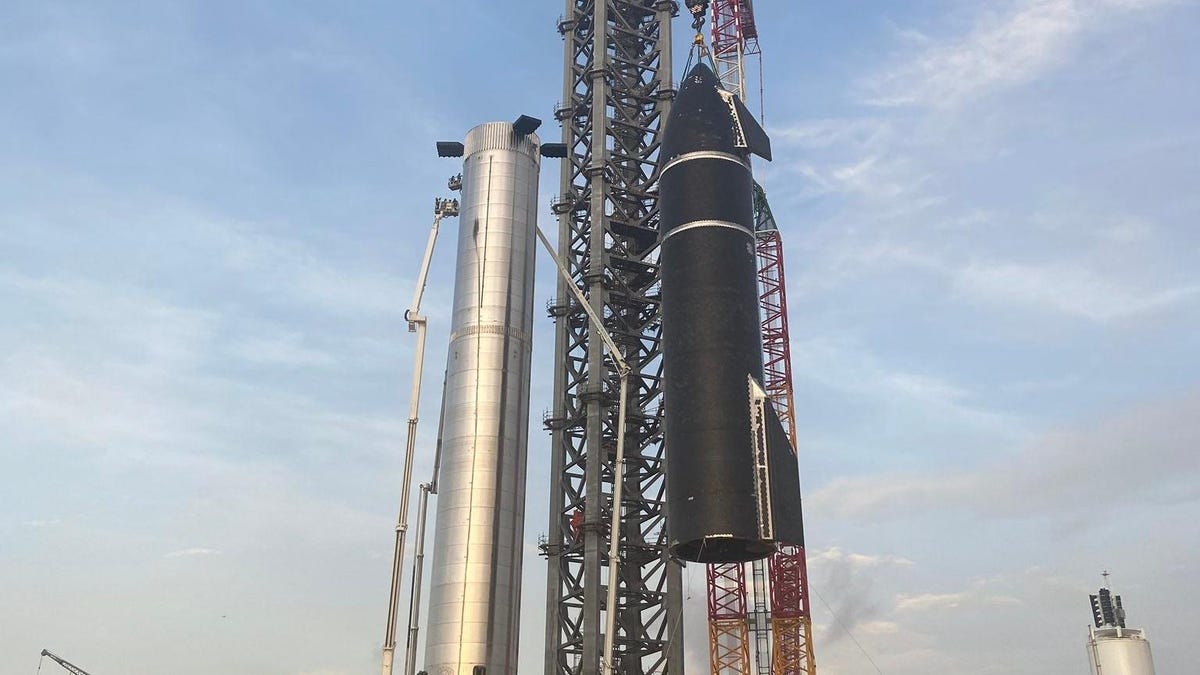SpaceX Starship Stacking Produces the Tallest Rocket Ever Built

Earlier today, engineers with SpaceX ever-so-carefully placed a Starship second-stage rocket atop a Super Heavy booster, resulting in the tallest rocket ever built, albeit a rocket that has yet to leave Earth’s surface.
At 394 feet tall, the newly constructed Starship system is taller than NASA’s Apollo-era Saturn V rocket (362.9 feet) and also NASA’s upcoming SLS rocket when stacked in the Block 2 cargo configuration (365.1 feet). SpaceX CEO Elon Musk proudly displayed images of the impressive structure on Twitter, describing it as “Starship Fully Stacked.”
The booster, BN4, was moved to the orbital launch mount on August 3. A stunning photo shows the bottom of the rocket shortly after all 29 Raptor engines were installed. The top and bottom components of the rocket are both 30 feet (9 meters) wide, with the Super Heavy measuring 230 feet (70 meters) tall and Starship measuring 160 feet (50 meters) tall.
SpaceX has since removed the top rocket, SN20, and returned it to the hangar for further work. The private company is hoping to launch the stacked pair later this year, though a firm date has not been established.
G/O Media may get a commission
But there’s still plenty of work to do before this giant takes to the skies and beyond. SpaceX still needs to conduct ground tests of the system, including fueling, pressurization, and static firing. And then there’s that pesky environmental review currently being prepared by the U.S Federal Aviation Administration, which, until the results are known, means the entire project is in a state of limbo.
This uncertainty hasn’t stopped Musk, who recently tweeted, “Starbase is moving at Warp 9,” in reference to construction work currently underway at the Boca Chica launch facility. The company is building the Orbital Launch Site (OLS), from which the Starship system is expected to both launch and land. The tempo of work at the Texas facility has increased dramatically in recent weeks, with hundreds of workers brought in from other SpaceX sites across the country, as NASASpaceflight reports. That SpaceX was selected by NASA to build a Moon lander for the upcoming Artemis missions might have something to do with the frenetic pace.
During the planned inaugural orbital test of the stacked Starship system, the BN4 Super Heavy booster will fire for 169 seconds before the second-stage Starship section separates. The booster will then fall and splashdown in the Gulf of Mexico some 20 miles (32 km) from the launch site. Starship will resume the journey, enter Earth orbit, and re-enter prior to making a full revolution. Starships SN20 will splashdown in the Pacific Ocean near the Hawaiian island of Kauai.
Once complete, the stainless steel rocket will be the most powerful launch vehicle ever built, capable of lifting 150 tons to orbit. The booster will run on sub-cooled liquid methane and liquid oxygen propellant, and exert 72 meganewtons of force (16,190,000 pounds of force) during liftoff.
The eventual plan is to have both components perform autonomous vertical landings. SpaceX finally managed to land a Starship prototype on May 5, 2021 after several failed attempts to do so. But those were suborbital tests; Starship will need to survive speeds reaching Mach 25 and the associated heat during orbital re-entry, and then perform a landing. The Super Heavy is designed to land on six legs, but SpaceX is moving ahead with an alternate scheme to catch the booster at the OLS tower.
SpaceX envisions Starship as a reusable system for transporting passengers and cargo to Earth orbit, the Moon, and Mars. SpaceX is currently under contract with NASA, for which they plan to demonstrate a modified crew-rated Starship vehicle for use during the upcoming Artemis lunar landings.
More: SpaceX lays out plan for first Starship orbital test flight.
Source link





